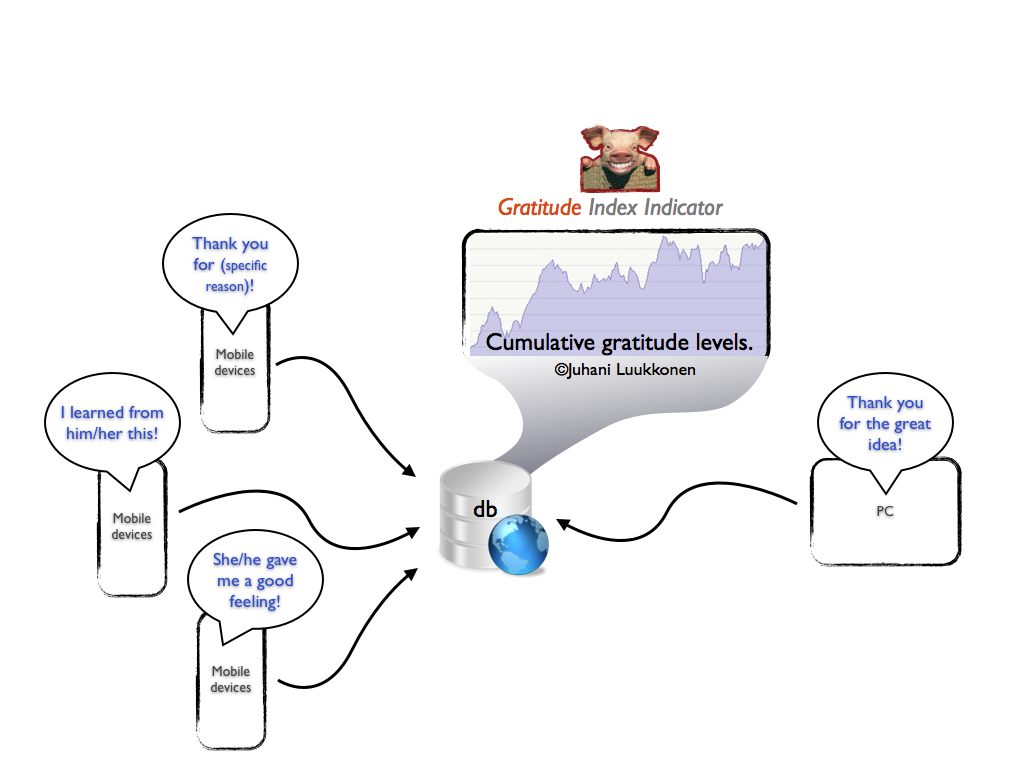Management by Gratitude it is one of the easiest ways to change organisational behaviour. It will create a gratitude index that is comparable between different organisations thus creating a global indicator for positive change at an organisational level. The practical implementation the Gratitude Index Indicator (GII) is described here.
In the most organisations performance measures are mirroring different KPIs (Key Performance Indicator) developed by the management to set up goals for individual employees. The appraisal process then looks at those KPIs and tries to asses if the goals are met. The whole process is patronising and based on industrial revolution's aftershocks in the business world where we used to think that the only measurable thing is monetary value. We have been measuring only tangible outputs, shareholder value and wealth. The problem is that we have not been able to measure motivation and the drivers beneath the visible performance of the organisation.
If we measure only performance, we create a negative culture, a law of jungle, survival of the fittest where only the ruthless (in a broad sense) can succeed – and often tramp on the good ideas coming from unexpected sources. In that kind of HR context we cannot see what the level of positive energy is in the organisation. We cannot identify whether or not the organisation is generating the positive energy required to meet and exceed the tangible goals.
To make Management by Active Gratitude method work we need to set up a Web2.0 system integrated with mobile platforms. It is a very easy and straight forward way to collect inputs from all levels of organisation.
High Level System Description
The core database of the Gratitude Index Indicator (GII) system stores inputs sent by all employees (including top management and the board) from their laptop or desktop computers, smart-phones or any other portable devices – or even paper stickers that can be then scanned to the system. The inputs are generated 'on the fly' in the real business situations based on text messages, simple touch based applications and similar user friendly methods (for example each employee name tag can have a barcode that could be read by smart phone – the technical applications are endless and the way the system is built for each organisation depends on the industry and type of the organisation). GII system also links all the employees from HR databases to GII system to avoid double handling of the data.
The GII Feedback Process
Every time an employee (this can be also widened to cover partners and other important stake-holders) experiences positive feedback from other people in the organisation, gets a good idea from somebody in the organisation or just feels uplifted and grateful because of somebody's support in the organisation he/she can send a GII message where the system automatically records the time and the sender of the message. In the message the employee identifies to whom he/she felt gratitude. This can be done by using codes or touch based quick-entry methods. The core message is to whom the employee is grateful to but there is also an option to add more information e.g. 'I felt gratitude because I got an idea from hi/her, I got some help, I got support' and so on.
The system sends reminder twice a day to an employee to send GII messages to keep the process alive.
Monitoring GII results: the carrots
The GII gives an overview how the positive feedback flows inside the organisation. Because it is an index based on individual inputs from organisation it can be set up to show the overall GII of the organisation and then down to a team level where teams can compare their GIIs. Individual employees can see only his/her own results against the average of the whole organisation. The reward systems can be built on the team GII results or individual GIIs of employees.
GII will have a dramatic impact on the increase of positive energy inside the organisation. Positive psychology by Martin Seligman lists the value of positive subjective experience as follows: well-being, contentment, and satisfaction (in the past); hope and optimism (for the future); and flow and happiness (in the present). GII will increase all those subjective and positive experiences. It will generate a positive self-fulfilling prophecy inside the organisation when people feel that their efforts and interactions amongst all the members of the organisation are respected and valued on a daily base and not just during the appraisal process. It supports positivity changes on the most fundamental level: inside each individual. Because GII results are based on what you give and not what you get it promotes and creates sharing, caring and more compassionate organisational culture.This will in the end show on the bottom line and as increased quality of products and services and better job satisfaction.
The first step is to find a pilot organisation whose top management is committed to apply Management by Active Gratitude and put GII in place.
The technical implementation of a GII system is very easy and could be done in stages starting from a simple web based application towards more complex multi-device model.
The buy-in of the individual employees comes through top management's example and creating simple interactive training e-learning model for the organisation.
I would like to thank my mentor in life, President Daisaku Ikeda (Soka Gakkai International) for his support and inspiration. Without his enlightened wisdom it would have been impossible to change my negativity into a positive and hope-filled mind-set I have now.
Also my study group at the Massey University's MBA course needs to be acknowledged for their support and friendship.
Special thanks to our lecturer Bernie Frey who got us to do this challenge and come up with our Moonshots.




You need to register in order to submit a comment.